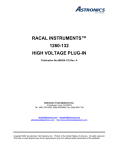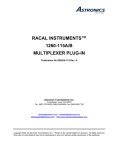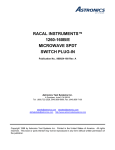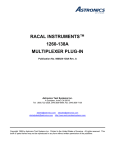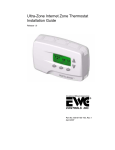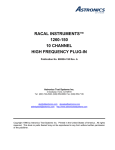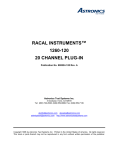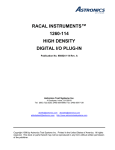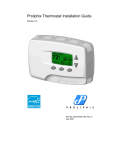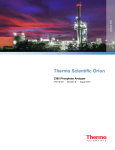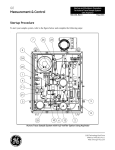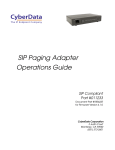Download Manual
Transcript
RACAL INSTRUMENTS™ 1260-136 MULTIPLEXER PLUG-IN Publication No. 980824-136 Rev. A Astronics Test Systems Inc. 4 Goodyear, Irvine, CA 92618 Tel: (800) 722-2528, (949) 859-8999; Fax: (949) 859-7139 [email protected] [email protected] [email protected] http://www.astronicstestsystems.com Copyright 1999 by Astronics Test Systems Inc. Printed in the United States of America. All rights reserved. This book or parts thereof may not be reproduced in any form without written permission of the publisher. THANK YOU FOR PURCHASING THIS ASTRONICS TEST SYSTEMS PRODUCT For this product, or any other Astronics Test Systems product that incorporates software drivers, you may access our web site to verify and/or download the latest driver versions. The web address for driver downloads is: http://www.astronicstestsystems.com/support/downloads If you have any questions about software driver downloads or our privacy policy, please contact us at: [email protected] WARRANTY STATEMENT All Astronics Test Systems products are designed to exacting standards and manufactured in full compliance to our AS9100 Quality Management System processes. This warranty does not apply to defects resulting from any modification(s) of any product or part without Astronics Test Systems express written consent, or misuse of any product or part. The warranty also does not apply to fuses, software, non-rechargeable batteries, damage from battery leakage, or problems arising from normal wear, such as mechanical relay life, or failure to follow instructions. This warranty is in lieu of all other warranties, expressed or implied, including any implied warranty of merchantability or fitness for a particular use. The remedies provided herein are buyer’s sole and exclusive remedies. For the specific terms of your standard warranty, contact Customer Support. Please have the following information available to facilitate service. 1. Product serial number 2. Product model number 3. Your company and contact information You may contact Customer Support by: E-Mail: [email protected] Telephone: +1 800 722 3262 (USA) Fax: +1 949 859 7139 (USA) RETURN OF PRODUCT Authorization is required from Astronics Test Systems before you send us your product or sub-assembly for service or calibration. Call or contact Customer Support at 1-800-722-3262 or 1-949-859-8999 or via fax at 1949-859-7139. We can also be reached at: [email protected]. If the original packing material is unavailable, ship the product or sub-assembly in an ESD shielding bag and use appropriate packing materials to surround and protect the product. PROPRIETARY NOTICE This document and the technical data herein disclosed, are proprietary to Astronics Test Systems, and shall not, without express written permission of Astronics Test Systems, be used in whole or in part to solicit quotations from a competitive source or used for manufacture by anyone other than Astronics Test Systems. The information herein has been developed at private expense, and may only be used for operation and maintenance reference purposes or for purposes of engineering evaluation and incorporation into technical specifications and other documents which specify procurement of products from Astronics Test Systems. TRADEMARKS AND SERVICE MARKS All trademarks and service marks used in this document are the property of their respective owners. • Racal Instruments, Talon Instruments, Trig-Tek, ActivATE, Adapt-A-Switch, N-GEN, and PAWS are trademarks of Astronics Test Systems in the United States. DISCLAIMER Buyer acknowledges and agrees that it is responsible for the operation of the goods purchased and should ensure that they are used properly and in accordance with this document and any other instructions provided by Seller. Astronics Test Systems products are not specifically designed, manufactured or intended to be used as parts, assemblies or components in planning, construction, maintenance or operation of a nuclear facility, or in life support or safety critical applications in which the failure of the Astronics Test Systems product could create a situation where personal injury or death could occur. Should Buyer purchase Astronics Test Systems product for such unintended application, Buyer shall indemnify and hold Astronics Test Systems, its officers, employees, subsidiaries, affiliates and distributors harmless against all claims arising out of a claim for personal injury or death associated with such unintended use. FOR YOUR SAFETY Before undertaking any troubleshooting, maintenance or exploratory procedure, read carefully the WARNINGS and CAUTION notices. This equipment contains voltage hazardous to human life and safety, and is capable of inflicting personal injury. If this instrument is to be powered from the AC line (mains) through an autotransformer, ensure the common connector is connected to the neutral (earth pole) of the power supply. Before operating the unit, ensure the conductor (green wire) is connected to the ground (earth) conductor of the power outlet. Do not use a two-conductor extension cord or a three-prong/two-prong adapter. This will defeat the protective feature of the third conductor in the power cord. Maintenance and calibration procedures sometimes call for operation of the unit with power applied and protective covers removed. Read the procedures and heed warnings to avoid “live” circuit points. Before operating this instrument: 1. Ensure the proper fuse is in place for the power source to operate. 2. Ensure all other devices connected to or in proximity to this instrument are properly grounded or connected to the protective third-wire earth ground. If the instrument: - fails to operate satisfactorily shows visible damage has been stored under unfavorable conditions has sustained stress Do not operate until performance is checked by qualified personnel. This page was left intentionally blank. Publication No. 980824-136 Rev. A 1260-136 User Manual Table of Contents Chapter 1 ............................................................................................................................ 1-1 SPECIFICATIONS ........................................................................................................................ 1-1 Introduction – 1260-136B .......................................................................................................... 1-1 Specifications – 1260-136B ....................................................................................................... 1-2 Power Dissipation – 1260-136B................................................................................................. 1-3 Introduction – 1260-136C .......................................................................................................... 1-4 Specifications – 1260-136C ....................................................................................................... 1-4 Power Dissipation – 1260-136C ................................................................................................ 1-5 Introduction – 1260-136D .......................................................................................................... 1-6 Specifications – 1260-136D ....................................................................................................... 1-7 Power Dissipation – 1260-136D ................................................................................................ 1-8 About MTBF .............................................................................................................................. 1-9 Ordering Information ................................................................................................................. 1-9 Chapter 2 ............................................................................................................................ 2-1 INSTALLATION INSTRUCTIONS ................................................................................................. 2-1 Unpacking and Inspection ......................................................................................................... 2-1 Installation ................................................................................................................................. 2-1 Module Configuration ................................................................................................................ 2-2 Front Panel Connectors ......................................................................................................... 2-2 Mating Connectors ................................................................................................................. 2-4 Astronics Test Systems i 1260-136 User Manual Publication No. 980824-136 Rev. A Chapter 3 ............................................................................................................................ 3-1 MODULE OPERATION ................................................................................................................ 3-1 Setting the Module Address ...................................................................................................... 3-1 Operating Modes ....................................................................................................................... 3-2 Operating In Message-Based Mode .......................................................................................... 3-4 Port Descriptors For The 1260-136 ....................................................................................... 3-4 Reply To The MOD:LIST? Command .................................................................................... 3-5 Operating The 1260-136 in Register-Based Mode .................................................................... 3-6 1260-136 Example Code ..................................................................................................... 3-11 Chapter 4 ............................................................................................................................ 4-1 OPTIONAL ASSEMBLIES ............................................................................................................ 4-1 ii Astronics Test Systems Publication No. 980824-136 Rev. A 1260-136 User Manual List of Figures Figure 1-1, 1260-136 .................................................................................................................... 1-1 Figure 1-2, 1260-136D in the vertical position ............................................................................... 1-6 Figure 2-1, Front-Panel Connector Pin Numbering ....................................................................... 2-2 Figure 2-2, Relay Diagram ............................................................................................................ 2-3 Figure 2-3, Block Diagram ............................................................................................................ 2-4 Figure 3-1, Message-Based Mode of Operation ........................................................................... 3-3 Figure 3-2, Register-Based Mode of Operation............................................................................. 3-3 Astronics Test Systems iii 1260-136 User Manual Publication No. 980824-136 Rev. A List of Tables Table 2-1, 1260-136 Front-Panel Connections ............................................................................. 2-3 Table 3-1, Register Offset Addresses of the 1260-136 Module .................................................... 3-7 Table 3-2, ID Register Functionality of the 1260-136 .................................................................... 3-7 Table 3-3, Port A Register Functionality of the 1260-136 Module ................................................. 3-8 Table 3-4, Port B Register Functionality of the 1260-136 Module ................................................. 3-8 Table 3-5, Port C Register Functionality of the 1260-136 Module ................................................. 3-8 Table 3-6, Port D Register Functionality of the 1260-136 Module ................................................. 3-9 Table 3-7, Port E Register Functionality of the 1260-136 Module ................................................. 3-9 Table 3-8, Port F Register Functionality of the 1260-136 Module ................................................. 3-9 Table 3-9, EPROM Descriptor Functionality of the 1260-136 Module ......................................... 3-10 iv Astronics Test Systems Publication No. 980824-136 Rev. A 1260-136 User Manual DOCUMENT CHANGE HISTORY Revision Date A 9/16/08 No change 03/19/09 Astronics Test Systems Description of Change Revised per EO 29379 Revised format to current standards. Company name revised throughout manual. Manual now revision letter controlled. Added Document Change History Page v. Back of cover sheet. Revised Warranty Statement, Return of Product, Proprietary Notice and Disclaimer to current standards. Removed Reshipment Instructions in (Chap. 2-1) and removed (Chap 5). Information. Now appears in first 2 sheets behind cover sheet. Updated table of contents to reflect changes made. . v 1260-136 User Manual Publication No. 980824-136 Rev. A This page was left intentionally blank. vi Astronics Test Systems Publication No. 980824-136 Rev. A 1260-136 User Manual Chapter 1 SPECIFICATIONS Introduction – 1260-136B The 1260-136B is a plug-in switch module developed for the 1260-100 Adapt-a-Switch Carrier. This switch is a softwareconfigurable 1X42 or 2X21 switch which provides up to 500VDC channel isolation at 0.5A/10W. The 1260-136B includes the following features: • Standard Adapt-a-Switch plug-in design, providing for ease of replacement • Data-Driven embedded descriptor, allowing immediate use with any Option-01T switch controller, regardless of firmware revision level. Figure 1-1, 1260-136 Astronics Test Systems Specifications1-1 1260-136 User Manual Specifications – 1260-136B Publication No. 980824-136 Rev. A Chan. Input Voltage 500VDC maximum† 500VAC pk-pk Chan. Output Current 0.5 A maximum Chan. Output Power 10 W maximum Path Resistance 0.850 Ω maximum Contact Bounce Time 0.25 ms typical Switch Contact Lifetime 100 Million Cycles (low-level) 1 Million Cycles (maximum rating) Available I/O Channels 21 (dual wire mode) 42 (single wire mode) Breakdown Voltage 1500 VDC Insulation Resistance 10 ohms Shock 30g, 11 ms, ½ sine wave Vibration 0.013 in. P-P, 5-55 Hz Bench Handling 4 in., 45° Cooling See 1260-100 cooling data Temperature Operating Non-operating 0°C to +55°C -40°C to +75°C Relative Humidity Altitude Operating Non-operating Power Requirements +5 VDC 9 85% + 5% non-condensing at < 30°C 10,000 feet 15,000 feet 1.2 A maximum with all channels closed Weight 9 oz. Mean Time Between Failures (MTBF) TBD Channel to Chassis Capacitance <150pF Mean Time to Repair < 5 minutes (MTTR) †Refer to warning about high-voltages in Chapter 2: Installation Instructions Specifications 1-2 Astronics Test Systems Publication No. 980824-136 Rev. A Power Dissipation – 1260-136B 1260-136 User Manual The cooling of the Adapt-a-Switch carrier is dependent upon the chassis into which it is installed. The carrier can nominally dissipate approximately 100W. Even with all channels driven to maximum outputs, up to six 1260-136 plug-ins may be used together in a 1260-100 without exceeding the maximum allowable power dissipation of the carrier. If the 1260-136B will be used in conjunction with other cards, the dissipation should be computed and summed with the total worstcase dissipation of the remaining modules. For example, a 1260-136B module would dissipate the following energy: Quiescent power dissipation = 0.75W maximum Channel dissipation = [(# channels energized) * (relay coil dissipation)] + [(channel current)2 * (path resistance) * 2] Total Power Dissipation = Quiescent + Channel Assuming the card is configured in the 2X21 mode of operation (worse case situation) operating with the maximum path current allowed in the A and B commons of 0.5A, a path resistance of 0.850Ω, and all relays engaged: Total power dissipation = [(42) * (0.085)] + [(0.5)2 * (0.850) * 2] + {0.75] = 4.75W This is acceptable power dissipation for an individual plug-in module. If five additional modules are likewise loaded, then the overall carrier dissipation is approximately 27W, which is well within the cooling available in most commercial VXIbus chassis. Since the 1260-136 is a multiplexer card, having all relays engaged at once is unlikely and the power dissipation falls down further. For practical purposes, as the calculations illustrate, the 1260-136 contributes a negligible amount of thermal load on a chassis. Astronics Test Systems Specifications1-3 1260-136 User Manual Introduction – 1260-136C Publication No. 980824-136 Rev. A The 1260-136C is a plug-in switch module developed for the 1260-100 Adapt-a-Switch Carrier. This switch is a softwareconfigurable 1X42 or 2X21 switch which provides up to 1000VDC channel isolation at 1.0A/25W. The 1260-136C includes the following features: 1. Standard Adapt-a-Switch plug-in design, providing for ease of replacement 2. Data-Driven embedded descriptor, allowing immediate use with any Option-01T switch controller, regardless of firmware revision level. Specifications – 1260-136C Chan. Input Voltage 1000VDC maximum† 1000VAC pk-pk Chan. Output Current 1.0A maximum Chan. Output Power 25 W maximum Path Resistance 0.850Ω maximum Contact Bounce Time 0.25 ms typical Switch Contact Lifetime 100 Million Cycles (low-level) 1 Million Cycles (maximum rating) Available I/O Channels 21 (dual wire mode) 42 (single wire mode) Breakdown Voltage 1500 VDC Insulation Resistance 109 ohms Shock 30g, 11 ms, ½ sine wave Vibration 0.013 in. P-P, 5-55 Hz Bench Handling 4 in., 45° Cooling See 1260-100 cooling data Temperature Operating Non-operating 0°C to +55°C -40°C to +75°C Relative Humidity Specifications 1-4 85% + 5% non-condensing at < 30°C Astronics Test Systems Publication No. 980824-136 Rev. A 1260-136 User Manual Altitude Operating Non-operating Power Requirements +5 VDC 10,000 feet 15,000 feet 1.4 A maximum with all channels closed Weight 9 oz. Mean Time Between Failures (MTBF) TBD Channel to Chassis Capacitance <150pF Mean Time to Repair < 5 minutes (MTTR) †Refer to warning about high-voltages in Chapter 2: Installation Instructions Power Dissipation – 1260-136C The cooling of the Adapt-a-Switch carrier is dependent upon the chassis into which it is installed. The carrier can nominally dissipate approximately 100W. Even with all channels driven to maximum outputs, up to six 1260-136 plug-ins may be used together in a 1260-100 without exceeding the maximum allowable power dissipation of the carrier. If the 1260-136C will be used in conjunction with other cards, the dissipation should be computed and summed with the total worstcase dissipation of the remaining modules. For example, a 1260-136C module would dissipate the following energy: Quiescent power dissipation = 0.75W maximum Channel dissipation = [(# channels energized) * (relay coil dissipation)] + [(channel current)2 * (path resistance) * 2] Total Power Dissipation = Quiescent + Channel Assuming the card is configured in the 2X21 mode of operation (worse case situation) operating with the maximum path current allowed in the A and B commons of 1A, a path resistance of 0.850Ω, and all relays engaged: Total power dissipation = [(42) * (0.125)] + [(1)2 * (0.850) * 2] + {0.75] = 7.7W Astronics Test Systems Specifications1-5 1260-136 User Manual Publication No. 980824-136 Rev. A This is acceptable power dissipation for an individual plug-in module. If five additional modules are likewise loaded, then the overall carrier dissipation is approximately 40W, which is well within the cooling available in most commercial VXIbus chassis. Since the 1260-136 is a multiplexer card, having all relays engaged at once is unlikely and the power dissipation falls down further. For practical purposes, as the calculations illustrate, the 1260-136 contributes a negligible amount of thermal load on a chassis. Introduction – 1260-136D The 1260-136D is a plug-in switch module developed for the 1260-100 Adapt-a-Switch Carrier. This switch is a softwareconfigurable 1X42 or 2X21 switch which provides up to 500VDC channel isolation at 1A/50W using mercury-wetted contacts for maximum reliability. CAUTION The 1260-136D is a position sensitive card and must be used with the card in the vertical position for correct operation (see the following diagram). 1260-136 in the vertical position The 1260-100 in the vertical position The chassis in the vertical position Figure 1-2, 1260-136D in the vertical position Specifications 1-6 Astronics Test Systems Publication No. 980824-136 Rev. A 1260-136 User Manual The 1260-136D includes the following features: Specifications – 1260-136D • Standard Adapt-a-Switch plug-in design, providing for ease of replacement • Data-Driven embedded descriptor, allowing immediate use with any Option-01T switch controller, regardless of firmware revision level. Chan. Input Voltage 500VDC maximum† 500VAC pk-pk Chan. Output Current 1 A maximum Chan. Output Power 50 W maximum Path Resistance 0.850 Ω maximum Contact Bounce Time none Switch Contact Lifetime 1 Billion Cycles (low-level) 50 Million Cycles (maximum rating) Available I/O Channels 21 (dual wire mode) 42 (single wire mode) Breakdown Voltage 1500 VDC Insulation Resistance 109 ohms Shock 30g, 11 ms, ½ sine wave Vibration 0.013 in. P-P, 5-55 Hz Bench Handling 4 in., 45° Cooling See 1260-100 cooling data Temperature Operating Non-operating 0°C to +55°C -40°C to +75°C Relative Humidity Altitude Operating Non-operating Astronics Test Systems 85% + 5% non-condensing at < 30°C 10,000 feet 15,000 feet Specifications1-7 1260-136 User Manual Publication No. 980824-136 Rev. A Power Requirements +5 VDC 1.4 A maximum with all channels closed Weight 9 oz. Mean Time Between Failures (MTBF) TBD Channel to Chassis Capacitance Mean Time to Repair <150pF < 5 minutes (MTTR) †Refer to warning about high-voltages in Chapter 2: Installation Instructions Power Dissipation – 1260-136D The cooling of the Adapt-a-Switch carrier is dependent upon the chassis into which it is installed. The carrier can nominally dissipate approximately 100W. Even with all channels driven to maximum outputs, up to six 1260-136 plug-ins may be used together in a 1260-100 without exceeding the maximum allowable power dissipation of the carrier. If the 1260-136D will be used in conjunction with other cards, the dissipation should be computed and summed with the total worstcase dissipation of the remaining modules. For example, a 1260-136D module would dissipate the following energy: Quiescent power dissipation = 0.75W maximum Channel dissipation = [(# channels energized) * (relay coil dissipation)] + [(channel current)2 * (path resistance) * 2] Total Power Dissipation = Quiescent + Channel Assuming the card is configured in the 2X21 mode of operation (worse case situation) operating with the maximum path current allowed in the A and B commons of 1A, a path resistance of 0.850Ω, and all relays engaged: Total power dissipation = [(42) * (0.125)] + [(1)2 * (0.850) * 2] + {0.75] = 7.7W This is acceptable power dissipation for an individual plug-in Specifications 1-8 Astronics Test Systems Publication No. 980824-136 Rev. A 1260-136 User Manual module. If five additional modules are likewise loaded, then the overall carrier dissipation is approximately 39 W, which is well within the cooling available in most commercial VXIbus chassis. Since the 1260-136 is a multiplexer card, having all relays engaged at once is unlikely and the power dissipation falls down further. For practical purposes, as the calculations illustrate, the 1260-136 contributes a negligible amount of thermal load on a chassis. About MTBF The 1260-136 MTBF is TBD. Ordering Information Listed below are part numbers for both the 1260-136 switch module and available mating connector accessories. Each 1260136 uses a single mating connector. ITEM 1260-136B 500V Switch Module DESCRIPTION PART # Switch Module, 1X42 / 2X21 500 VDC 407698-002 Consists of: P/N 405153-002 PCB Assy P/N 980824-136 Manual 1260-136C 1KV Switch Module Switch Module, 1X42 / 2X21 1KV 407698-003 Consists of: P/N 405153-003 PCB Assy P/N 980824-136 Manual 1260-136D HG Switch Module Switch Module, 1X42 / 2X21 500V Mercury-Wetted 407698-004 Consists of: P/N 405153-004 PCB Assy P/N 980824-136 Manual 160 Pin Connector Kit Additional Manual Astronics Test Systems 160 Pin Connector Kit 407664-001 980824-136 Specifications1-9 1260-136 User Manual Publication No. 980824-136 Rev. A This page was left intentionally blank. Specifications 1-10 Astronics Test Systems Publication No. 980824-136 Rev. A 1260-136 User Manual Chapter 2 INSTALLATION INSTRUCTIONS Unpacking and Inspection 1. Remove the 1260-136 module and inspect it for damage. If any damage is apparent, inform the carrier immediately. Retain shipping carton and packing material for the carrier’s inspection. 2. Verify that the pieces in the package you received contain the correct 1260-136 module option and the 1260-136 Users Manual. Notify Customer Support if the module appears damaged in any way. Do not attempt to install a damaged module into a VXI chassis. 3. The 1260-136 module is shipped in an anti-static bag to prevent electrostatic damage to the module. Do not remove the module from the anti-static bag unless it is in a staticcontrolled area. Installation Astronics Test Systems Installation of the 1260-136 Switching Module into a 1260-100 Carrier assembly is described in the Installation section of the 1260-100 Adapt-a-Switch Carrier Manual. Installation Instructions 2-1 1260-136 User Manual Publication No. 980824-136 Rev. A Module Configuration The 1260-136 is a software-selectable 1X42 or 2X21 multiplexer I/O plug-in for the Adapt-a-Switch Series. It is available in several variations having different switching voltages, currents, and contact materials (refer to Chapter 1 for more information) to suit a wide variety of applications. Front Panel Connectors The 1260-136 has one 48-pin front-panel connector, labeled J200. It is a 48-pin, DIN “E” style, with 0.040” rectangular posts as pins. See Figure 2-1 for pin numbering. Table 2-1 shows the mapping of channel numbers to connector pins. Information about available mating connectors is provided immediately after Table 2-1. See Figure 2-2 for a block diagram of the 1260-136. E C A 32 30 28 26 24 22 20 18 16 14 12 10 8 6 4 2 Figure 2-1, Front-Panel Connector Pin Numbering Installation Instructions 2-2 Astronics Test Systems Publication No. 980824-136 Rev. A 1260-136 User Manual Table 2-1, 1260-136 Front-Panel Connections Pin # 2 4 6 8 10 12 14 16 18 20 22 24 26 28 30 32 0A 1A Row A 0A 0B 3A 3B Connector Pin Description Row C Row E 1A 2A 1B 2B 4A 5A 4B 5B 6A 6B 9A 9B COMMONB COMMONB 13A 13B 16A 16B 19A 19B 7A 7B 10A 10B 11A 11B 14A 14B 17A 17B 20A 20B 8A 8B COMMONA COMMONA 12A 12B 15A 15B 18A 18B NO CONNECT NO CONNECT 2A COM A AB K43 0..........20 100......120 200......220 1000 A B A&B AB COM B 0B 1B 2B Figure 2-2, Relay Diagram Astronics Test Systems Installation Instructions 2-3 1260-136 User Manual Publication No. 980824-136 Rev. A Vcc Com 1x42 or 2x21 Chans NO Readback 48 PIN CARD INTERFACE CONNECTOR Control 1260-136 BLOCK DIAGRAM Parallel to Serial Converter Gnd Input Latches 8x6 48 PIN USER INTERFACE CONNECTOR Readback Com Control Information Reed Relay Module Driver Logic Core NO Gnd Serial to Parallel Converter Output Latches 8x6 Control Figure 2-3, Block Diagram Mating Connectors Mating connector accessories are available: 160-Pin Connector Kit with backshell and pins, P/N 407664-001 The 48-Pin Connector Kit consists of a connector housing, and 60 crimp pins. After wire attachment, the pin is inserted into the housing and will snap into place, providing positive retention. The suggested hand tool for the crimp pins is P/N 990898. The corresponding pin removal tool is P/N 990899. Installation Instructions 2-4 Astronics Test Systems Publication No. 980824-136 Rev. A 1260-136 User Manual Chapter 3 MODULE OPERATION Setting the Module Address The Option-01T switch controller identifies each Adapt-a-Switch plug-in or conventional 1260-Series module by a module address that is unique to that module. The module address is a number from 1 through 12, inclusive. The module address assigned to the 1260-136 depends on the carrier slot into which the 1260-136 is inserted, and on the position of the logical address DIP switch on the carrier side panel. The switch has two settings: • 1-6 (closed): When the switch is set to this position, the module addresses of the plug-ins in the 1260-100 Carrier are from 1 through 6. The module with address 1 is in the left slot of the top row. The plug-ins are addressed in the following pattern: 1 2 3 4 5 6 Front View – Module Addresses for 1 through 6 • Astronics Test Systems 7 - 12 (open): When the switch is set to this position, the Module Operation 3-1 1260-136 User Manual Publication No. 980824-136 Rev. A module addresses of the plug-ins in the 1260-100 Carrier are from 7 through 12, in the following pattern: 7 8 9 10 11 12 Front View – Module Addresses for 7 through 12 When setting module addresses for Adapt-a-Switch Carriers and conventional 1260-Series modules, be sure that no address is used by more than one plug-in or 1260-Series module. For instructions on setting module addresses for a conventional 1260-Series module, see the label on the side panel of the module. Operating Modes The 1260-136 may be operated either in message-based mode or in register-based mode. In the message-based mode, the 1260-01T switch controller interprets commands sent by the slot 0 controller, and determines the appropriate data to send to the control registers of the 1260136 module. If the A24 VXI base address for the 1260-100 Adapt-A-Switch carrier is assumed to be at 0x804000A for example purposes and the 1260-136 occupies the module 0 slot, Figure 3-1 below provides a conceptual view of the message-based mode of operation for a read operation on port 1. Module Operation 3-2 Astronics Test Systems Publication No. 980824-136 Rev. A 1260-136 User Manual "DIG:INP? (@1(1))" VXIbus PC (MXI) Read from A24 Address {base address + 0x401} 1260-01T 1260-136 Figure 3-1, Message-Based Mode of Operation In the register-based mode, the user writes directly to the port registers on the 1260-136 module. The 1260-01T command module does not monitor these operations, and does not keep track of the port states on the 1260-136 module in this mode. A conceptual view of the register-based mode is shown in Figure 3-2 below. Read from A24 Address {base address + 0x401} PC (MXI) 1260-136 Figure 3-2, Register-Based Mode of Operation Since the 1260-01T switch controller does not keep track of port and control register states during the register-based mode, it is advisable to use either the message-based or the register-based mode consistently, and use the chosen mode exclusively throughout the application program. In general, the message-based mode of operation is easier to use with utility software such as the National Instruments VXI Interactive Control (VIC) program. The message-based mode allows the user to send ASCII text commands to the 1260-01T and to read replies from the 1260-01T. In addition, some features, such as synchronous port operation, are available only in the message-based mode. An added benefit of message-based operation is that it obviates the need to manually configure control registers on the 1260-136, controlling such things as port data direction, since these are handled automatically by the 1260-01T. The register-based mode provides faster and more direct control of the 1260-136. In this mode, direct port and control register operations are processed in less than 9 microseconds, not Astronics Test Systems Module Operation 3-3 1260-136 User Manual Publication No. 980824-136 Rev. A counting software overhead inherent in I/O libraries such as VISA. For further information about message-based vs. register-based comparisons, consult the 1260-01T User’s Manual for further details. Operating In Message-Based Mode Port Descriptors For The 1260-136 The standard 1260-01T commands are used to operate the 1260136 module. These commands are described in the 1260-01T User’s Manual. Each 1260-01T port command uses a port descriptor (also referred to as a channel descriptor in some documentation) to select the port(s) of interest. The syntax for a port descriptor is the same for all 1260 series modules. In general, the following syntax is used to select a single port: (@ <module address> ( <port> ) ) Where: • <module address> is the address of the 1260-136 module. This is a number is in the range from 1 through 12, inclusive. • <port> is the 1260-136 port to operate. This is a number in the range from 0 through 1000. “Ports” 0-20 100-120 1000 A Relays 0 0A 1 1A 2 2A etc. B Relays 0 0B 1 1B etc. AB Relay (determines whether the card is configured as 2X21 or 1X42) Multiple individual ports may be specified using the following port descriptor syntax: @ <module address> ( <port1> , <port2> , . . ., <portN> ))[,data] A range of ports may be specified using the following channel descriptor syntax: @ <module address> ( <first port> : Module Operation 3-4 Astronics Test Systems Publication No. 980824-136 Rev. A 1260-136 User Manual <last port> )) The following examples illustrate the use of the port descriptors for the 1260-136: CLOSE (@8(0)) OPEN (@3(1)) Reply To The MOD:LIST? Command Closes port 0 relay at module address 8 Reads port 1 relay at module address 3 The 1260-01T returns a reply to the MOD:LIST? command. This reply is unique for each different 1260 series switch module. The syntax for the reply is: <module address> : <module-specific identification string> The <module-specific identification string> for the 1260-136 depends on the version. For the TTL, CMOS, standard opencollector and high voltage/current open collector, the strings are respectively: 1260-136B 500V 1X42 (2X21) MUX 1260-136C 1 KV 1X42 (2X21) MUX 1260-136D MERCURY 1X42 (2X21) MUX So, for a 1260-136C whose <module address> is set to 8, the reply to this query would be: 8 : 1260-136C 1 KV 1X42 (2X21) MUX Astronics Test Systems Module Operation 3-5 1260-136 User Manual Operating The 1260-136 in Register-Based Mode Publication No. 980824-136 Rev. A In register-based mode, the 1260-136 is operated by directly writing and reading to/from ports controlling eight relays each. To access the various registers the following details must be assembled to generate an absolute address that can be wrote or read from: The port and control registers are located in the VXIbus A24 Address Space. The A24 address for a port or control register depends on: 1. The A24 Address Offset assigned to the 1260-01T module by the Resource Manager program. The Resource Manager program is provided by the VXIbus slot-0 controller vendor. The A24 Address Offset is placed into the “Offset Register” of the 1260-01T by the Resource Manager. 2. The <module address> of the 1260-136 module. This is a value in the range from 1 and 12 inclusive. 3. The 1260-136 port or control register to be written to or read from. Each register on the 1260-136 has a unique offset from the base address. The base A24 address for the 1260-136 module may be calculated by: (A24 Offset of the 1260-01T) + (1024 x Module Address of 1260-136). The A24 address offset is usually expressed in hexadecimal. A typical value of 20400016 is used in the examples that follow. A 1260-136 with a module address of 7 would have the base A24 address computed as follows: Base A24 Address of 1260-136 = 20400016 + (40016 x 710) = 205C0016 The port and control registers for Adapt-a-Switch plug-ins and conventional 1260-Series modules are always on odd-numbered A24 addresses. For port registers, the 1260-136 reads and writes to the same location. For control registers, the 1260-136 writes to one location, but reads back from another. Table 3.1- 3.9 provides offsets relative to the base address of the module for all port and control registers of the 1260-136. To obtain the absolute address where data is to be written or read from, the base address is added to the offset: (Base A24 1260-136 Address) + offset = absolute address Module Operation 3-6 Astronics Test Systems Publication No. 980824-136 Rev. A 1260-136 User Manual So, for our example base A24 address computed earlier, the following absolute addresses would apply for the operations indicated: 205C01 Port A read or written at this location 205E01 ID register read at this location Before explaining the particulars of reading and writing to port and control registers, it is necessary to understand how the registers interact with the 1260-136 relays. Table 3.2 through 3.9 provide a detailed explanation of each register and how it interacts with the 1260-136 module. Table 3-1, Register Offset Addresses of the 1260-136 Module Register Offsets to Add to Base Module Address Register Name Write Location (hexadecimal) 0x01 0x03 0x05 0x07 0x09 0x0B Read Only Read Only Port A Port B Port C Port D Port E Port F ID EPROM Descriptor Read Location (hexadecimal) 0x01 0x03 0x05 0x07 0x09 0x0B 0x201 0x203 Table 3-2, ID Register Functionality of the 1260-136 ID Register Register Table Module Version All Astronics Test Systems Bit 0 1 2 3 4 5 6 7 Functionality Description Always Reads 0x00 (Read Only) Module Operation 3-7 1260-136 User Manual Publication No. 980824-136 Rev. A Table 3-3, Port A Register Functionality of the 1260-136 Module Port A Register Table Module Version All Bit 0 1 2 3 4 5 6 7 Relay 0A Relay 0B Relay 1A Relay 1B Relay 2A Relay 2B Relay 3A Relay 3B Functionality Description (0: contact open 1: contact closed) (0: contact open 1: contact closed) (0: contact open 1: contact closed) (0: contact open 1: contact closed) (0: contact open 1: contact closed) (0: contact open 1: contact closed) (0: contact open 1: contact closed) (0: contact open 1: contact closed) Table 3-4, Port B Register Functionality of the 1260-136 Module Port B Register Table Module Version All Bit 0 1 2 3 4 5 6 7 Relay 4A Relay 4B Relay 5A Relay 5B Relay 6A Relay 6B Relay 7A Relay 7B Functionality Description (0: contact open 1: contact closed) (0: contact open 1: contact closed) (0: contact open 1: contact closed) (0: contact open 1: contact closed) (0: contact open 1: contact closed) (0: contact open 1: contact closed) (0: contact open 1: contact closed) (0: contact open 1: contact closed) Table 3-5, Port C Register Functionality of the 1260-136 Module Port C Register Table Module Version All Module Operation 3-8 Bit 0 1 2 3 4 5 6 7 Relay 8A Relay 8B Relay 9A Relay 9B Relay 10A Relay 10B Relay 11A Relay 11B Functionality Description (0: contact open 1: contact closed) (0: contact open 1: contact closed) (0: contact open 1: contact closed) (0: contact open 1: contact closed) (0: contact open 1: contact closed) (0: contact open 1: contact closed) (0: contact open 1: contact closed) (0: contact open 1: contact closed) Astronics Test Systems Publication No. 980824-136 Rev. A 1260-136 User Manual Table 3-6, Port D Register Functionality of the 1260-136 Module Port D Register Table Module Version All Bit 0 1 2 3 4 5 6 7 Relay 12A Relay 12B Relay 13A Relay 13B Relay 14A Relay 14B Relay 15A Relay 15B Functionality Description (0: contact open 1: contact closed) (0: contact open 1: contact closed) (0: contact open 1: contact closed) (0: contact open 1: contact closed) (0: contact open 1: contact closed) (0: contact open 1: contact closed) (0: contact open 1: contact closed) (0: contact open 1: contact closed) Table 3-7, Port E Register Functionality of the 1260-136 Module Port E Register Table Module Version All Bit 0 1 2 3 4 5 6 7 Relay 16A Relay 16B Relay 17A Relay 17B Relay 18A Relay 18B Relay 19A Relay 19B Functionality Description (0: contact open 1: contact closed) (0: contact open 1: contact closed) (0: contact open 1: contact closed) (0: contact open 1: contact closed) (0: contact open 1: contact closed) (0: contact open 1: contact closed) (0: contact open 1: contact closed) (0: contact open 1: contact closed) Table 3-8, Port F Register Functionality of the 1260-136 Module Port F Register Table Module Version All Astronics Test Systems Bit 0 1 2 3 4 5 6 7 Relay 20A Relay 20B Relay 21A Relay 21B Reserved Reserved Reserved Relay AB Functionality Description (0: contact open 1: contact closed) (0: contact open 1: contact closed) (0: contact open 1: contact closed) (0: contact open 1: contact closed) (0: 2X21 mode 1: 1X42 mode) Module Operation 3-9 1260-136 User Manual Publication No. 980824-136 Rev. A Table 3-9, EPROM Descriptor Functionality of the 1260-136 Module EPROM Descriptor Register Register Table Module Version All Bit 0 1 2 3 4 5 6 7 Functionality Description This register each time read advances a memory pointer to the next memory location in an EPROM. To reset this pointer to the beginning, simply read the ID register and the memory pointer resets to zero. The descriptor register contains a long string of data, typically used by the Adapt-a-Switch carrier for configuration purposes. Additionally, this data has the card identification string for the specific type of card (i.e. 1260-136 500V or 1260-136 1KV). These identification strings are located at EPROM memory locations 0x23-0x34 Writing to a port location is a straightforward process. Setting a bit high in a port register causes the port to output a high logic level on the port pin corresponding to that bit. In the case of an opencollector version, this same operation would cause the pull-down transistor to activate. It is especially important to realize that a single write operation controls eight separate control lines or output devices simultaneously. Therefore if only a single bit change is desired, the following process must be observed. 1. Read the register first, inverting the bit pattern if necessary 2. Mask the appropriate bit with an ‘AND’ operation and a byte mask with all undesired bits set to a ‘1’ and the desired bit set to a ‘0’ or ‘1’ depending on whether the bit is to be set or cleared in the desired register 3. Write the masked data back into the register As simple as this may seem, a number of products reported as faulty and sent back for repair are nothing more than the result of inappropriate register accesses. Reading certain 1260-136 registers highlights a detail that must also be considered. Because of the 1260-136 relay driver architecture, registers A-F will readback inverted from what was written to the register. The VISA I/O library may be used to control the module. The VISA function viOut8() is used to write a single 8-bit byte to a control register, while viIn8() is used to read a single 8-bit byte from the control register. The following code example shows the use of viOut8() to update the 1260-136 module. Module Operation 3-10 Astronics Test Systems Publication No. 980824-136 Rev. A 1260-136 User Manual 1260-136 Example Code #include <visa.h> /* This example shows a 1260-01T at logical address 16 and a VXI/MXI */ /* interface */ #define RI1260_01_DESC "VXI::16" /* For a GPIB-VXI interface, and a logical address of 77 */ /* the descriptor would be: "GPIB-VXI::77" */ /* this example shows a 1260-136 with module address 7, port 1, and write data of 0xAA */ #define MOD_ADDR_136 7 #define PORT_NUMBER 1 #define DATA_ITEM 0xAA void example_operate_1260_136(void) { ViUInt8 creg_val; ViBusAddress portA_addr, offset; ViSession hdl1260; /* VISA handle to the 1260-01T */ ViSession hdlRM; /* VISA handle to the resource manager */ ViStatus error; /* VISA error code */ /* open the resource manager */ /* this must be done once in application program */ error = viOpenDefaultRM (&hdlRM); if (error < 0) { /* error handling code goes here */ } /* get a handle for the 1260-01T */ error = viOpen (hdlRM, RI1260_01_DESC, VI_NULL,VI_NULL, &hdl1260); if (error < 0) { /* error handling code goes here */ } /* form the offset for control register 0 */ /* note that the base A24 Address for the 1260-01T */ /* is already accounted for by VISA calls viIn8() and */ Astronics Test Systems Module Operation 3-11 1260-136 User Manual Publication No. 980824-136 Rev. A /* viOut8() */ /* module address shifted 10 places = module address x 1024 */ portA_addr = (MOD_ADDR_136 << 10) + 1; offset = portA_addr + (PORT_NUMBER << 1); error = viOut8 (vi, VI_A24_SPACE, offset, DATA_ITEM); if (error < 0) return( error ); /* close the VISA session */ error = viClose( hdl1260 ); if (error < 0) { /* error handling code goes here */ } } Module Operation 3-12 Astronics Test Systems Publication No. 980824-136 Rev. A 1260-136 User Manual Chapter 4 OPTIONAL ASSEMBLIES 407664 Connector Kit, 160 Pin Crimp ............................................................... 4-3 407408-001 Cable Assy, 160 Pin, 6 ft, 24AWG........................................................ 4-4 Astronics Test Systems Optional Assemblies 4-1 1260-136 User Manual Publication No. 980824-136 Rev. A This page was left intentionally blank. Optional Assemblies 4-2 Astronics Test Systems Publication No. 980824-136 Rev. A Assembly 407664 Connector kit, 160 Pin, Crimp # 1 2 Component 602258-116 602258-900 Astronics Test Systems 1260-136 User Manual Rev Date 7/30/98 Revision A Description CON-CAB-RCP160C,100S TRMCRP-SNP-U-F26-20G U/M -E EA -E EA Qty Reqd. 1.000 170.000 REF Optional Assemblies 4-3 Optional Assemblies 4-4 3 10 1.0" 407408-001 REV. CABLE 1 407408-001 REV. CABLE 2 72.0±2.0 .75" ±.25" 2 PLCS A/R ±.25" 2 11 2 PLCS 2 PLCS A/R 3 407408-001 REV. CABLE 1 407408-001 REV. CABLE 2 72.0±2.0 B (CABLE NOT SHOWN) VIEW B-B B PIN A1 PIN E32 C 1 2 PLCS A 2 4 1 POSITION LOCKING HEAD AS CLOSE TO STRAIN RELIEF BRACKET AS POSSIBLE 4 PLCS SH. 9 A (CABLE NOT SHOWN) 6 407408-001 8 7 PIN E32 5 4 BAG CABLE ASSEMBLY AND IDENTIFY WITH RACAL PART NUMBER "407408-001" AND CURRENT REVISION LETTER. 5. 160 PLCS IDENTIFY CABLES AS SHOWN USING INDELIBLE BLACK INK ON YELLOW SHRINK TUBING (ITEM 11). COVER WITH CLEAR SHRINK TUBING (ITEM 1) FOR IDENTIFICATION PROTECTION. 4 PIN A1 CABLES ARE TO BE BUILT IN PAIRS FOR EASE OF TESTING. TEST CABLE ASSY USING TEST PROCEDURE 951016. AFTER ASSY PASSES TEST, CUT THE CABLE IN HALF, MAKING TWO SEPARATE CABLE ASSEMBLIES. 3 VIEW A-A TERMINATE CABLE INSULATION AS SHOWN, USING SHRINK TUBING (ITEM 10). 2 D DWG. NO. B C SEE WIRE LIST FOR CONTACT ASSIGNMENTS AND CONNECTIONS. 1. NOTES: 1260-136 User Manual Publication No. 980824-136 Rev. A REV. A Astronics Test Systems










































